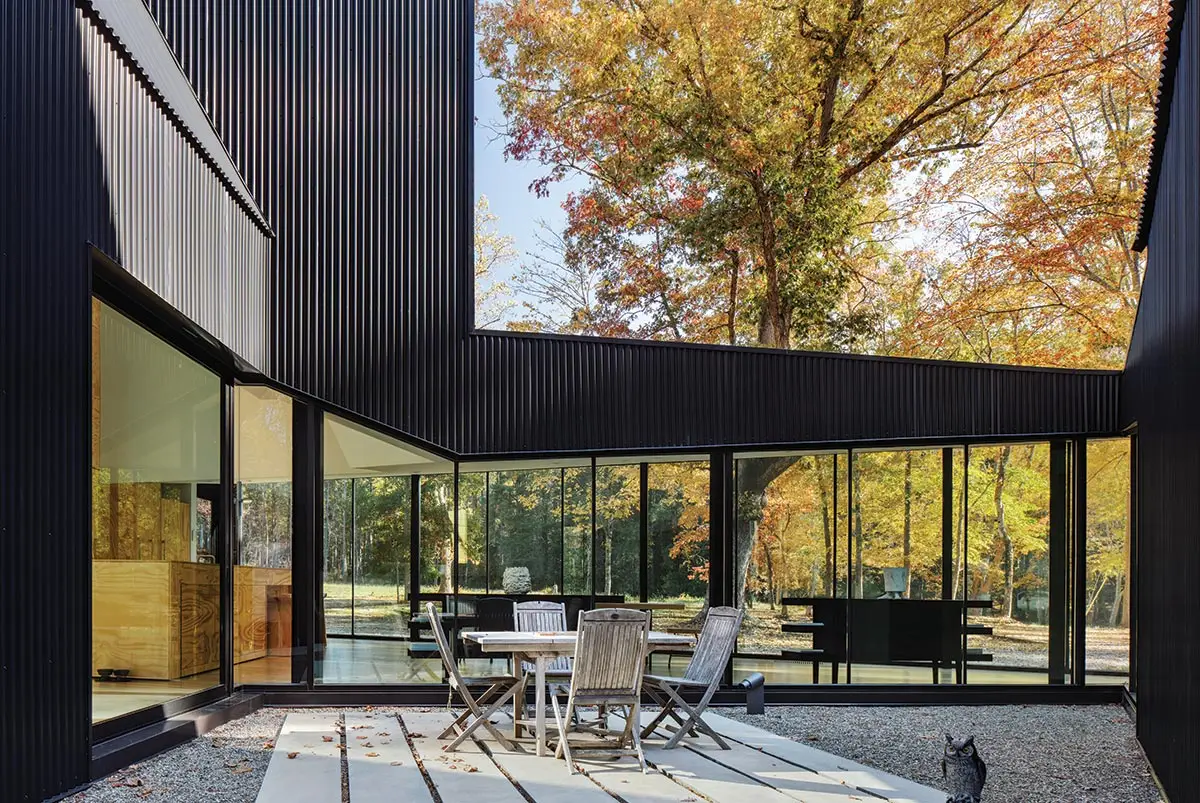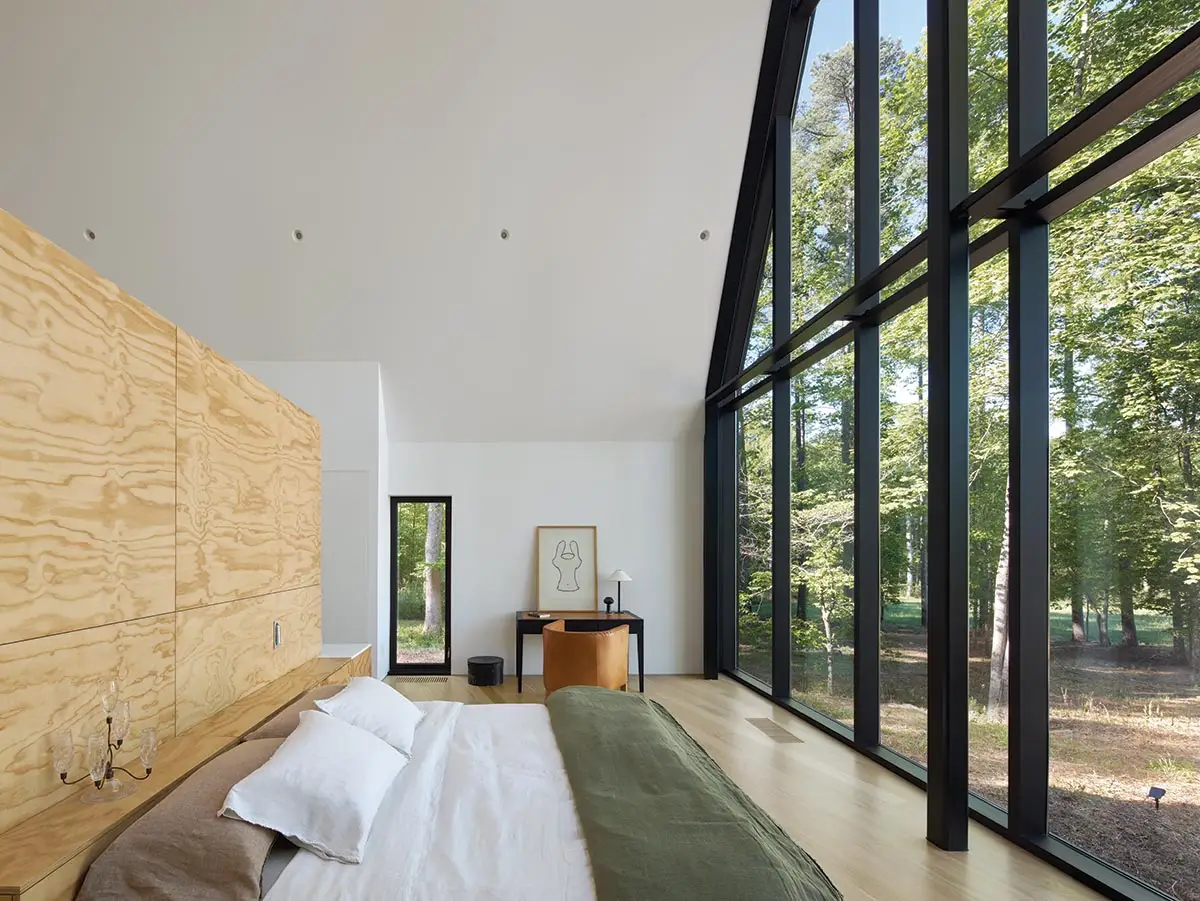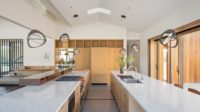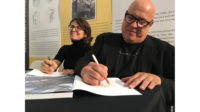After living and working in greater Los Angeles for 25 years, Steve and Kim Chase were eager to move back East. Natives of Montreal, they wanted a quieter life on a rural site, but without the bone-chilling Canadian winters. Lured both by their positive impressions of the region and the proximity of friends, they chose North Carolina as their new home.
There, on a wooded 60-acre site in the rolling hills near Hillsborough, they’ve built a striking 2,570-square-foot house that feeds the energy of the intensely creative couple while satisfying their high expectations for visual order and uncompromising design—a house that’s seemingly so simple, yet so nuanced.
Set among the towering pines, the Steeplechase House is a place of reflection and tranquility. (The moniker is a play on words, a reflection of the couple’s name and the fact that Kim has a long-standing passion for all things equestrian.) Two elemental forms—steep-roofed gabled boxes, each measuring 25 by 55 feet in plan—rest quietly among the trees, reflecting the landscape in broad expanses of mirrored glass while inviting the natural environment inside.
“I thought it was the right thing for that site, and it allows the building to extend into the landscape,” says Lawrence Scarpa, principal at Brooks + Scarpa of Los Angeles, who previously designed an office for Steve’s company, Reactor Films, that was completed in 1998. “In the summer, it’s almost as though it’s cloaked, where you don’t even see the house because it’s so dark.”
Clad in black corrugated steel, the two main volumes pinch toward each other on the west-facing side, forming a triangular courtyard that’s enclosed on the back by a low-slung loggia with floor-to-ceiling glass. While renting a place to live during their search for a building site, the Chases had come across an old board-and-batten chapel in Hillsborough and were drawn to its scale and simplicity. “We thought we could do something maybe that simple, but perhaps two of them—like a little compound,” says Kim.

1
The two volumes are connected by a triangular courtyard (1 & 2). Photos © Mark Herboth, click to enlarge.

2
The structure’s reflective glass and black exterior give the building an ever-changing presence through the seasons, receding into the forest’s dappled light in the summer and playing hide-and-seek among the tree trunks in winter. It’s well suited to the artistic couple, both of whom worked as art directors and have extensive photography experience. “We don’t get any high-angled light in this house,” notes Steve, a Clio Award–winning film producer, “so, in the early evening, it’s only the prettiest light. And when you get up in the morning, you get light filtering through the trees. It’s pretty cool.”
The two main volumes define the public and private zones of the house, with the transitional loggia housing the kitchen and dining area. As one steps from the loggia into the living area, the space explodes upward to an apex of 31 feet. Framed by a delicate steel grid, the view extends through the trees into a meadow carved from the forest.
Cabinets and shelves are built of plywood with a natural finish, providing warmth to the interior but maintaining an outdoorsy, cabinlike feel. The plywood finishes are complemented by French white oak flooring, which brightens the space.

3
Plywood with a natural finish was used for cabinetry, while floors are French white oak (3 & 4). Photos © Mark Herboth

4
The private side of the house is dominated by the light-filled primary bedroom, with its generous plywood-encased wardrobe and open walk-in shower and tub. Tucked behind is a laundry room and guest bedroom, whose Murphy bed is usually folded away so the space can be used as an office. (Future plans include a guest house on the site.)
A distinguishing feature is the house’s two projecting skylights—one on each of the pavilions. Playfully referred to by the Chases as “findows” (or finlike windows), the two rooftop registers allow changing displays of light and shadow that emphasize the sculptural form of the interior. The effect is subtly enhanced by the complex geometry of the two pavilions, whose walls are not parallel, just as the slightly angled spring lines of the gabled roofs are not horizontal. “It added some complexity, but also I think some interest, because the spring line inside is actually sloping,” says Scarpa. “It’s almost imperceptible, but you know it’s there.”

5
The tall windows and high ceilings capture light that changes throughout the day (5 & 6). Photos © Mark Herboth

6
It’s all part of the visceral experience of living here, where shifts in weather drastically alter the personality of the house. One minute it can be bright and sunny, Kim says, and the next there’s a threatening black sky with the loblolly pines bending in the wind. Furthering this connection to nature, the couple also helped restore the site’s ecology, clearing eight acres and planting heritage grasses such as bluestem, switchgrass, and rattlesnake master.

A restored landscape creates a habitat for bees, birds, and other wildlife. Photo © Mark Herboth
Designing and building the house has been a labor of love for the Chases, who each applied a discriminating eye to help achieve its refined sense of craft. While they took a largely hands-off approach to the design process, their involvement in the construction is reflected in the finished product. Steve, for example, built a full-scale mock-up of the knife-edged concrete stair descending from the courtyard to help contractors envision how it should look. For her part, Kim refused to accept the county’s code requirement for unsightly floor outlets to be placed every 12 feet in the loggia. As an alternative, she designed elegant wooden floor grilles that conceal both the air ducts and electrical outlets and can be lifted out if power is needed.
“It was just important for us to get it right,” says Kim, acknowledging the luxury of living nearby and having the time to watch the house take shape day by day. The Steeplechase House is the singular outcome of that opportunity—the product of a creative collaboration between client and architect, with a minimum of artistic direction and an abundance of trust.
Angela Brooks of Brooks + Scarpa is a 2024 Women in Architecture Awards honoree. A celebration of this year's winners will be held in New York City on October 1, following RECORD's 2024 Innovation Conference. Registration information can be found here.
Click plan to enlarge

Credits
Architect:
Brooks + Scarpa — Lawrence Scarpa, lead designer, principal in charge; Angela Brooks, Micaela Danko, Jeffrey Huber, Iliya Muzychuk, Chinh Nguyen, Fui Srivikorn, Calder Scarpa, Yimin Wu, Arty Vartanyan, design team
Associate Architect:
Katherine Hogan Architects
Engineer:
Kaydos-Daniels Engineers (structural)
Consultant:
Plan(t) (landscape)
General Contractor:
Tonic Construction, Vincent Petrarca
Client:
Steve and Kim Chase
Size:
2,575 square feet
Cost:
$1 million
Completion Date:
April 2024
Sources
Masonry:
Johnson Concrete
Curtain Wall:
YKK
Roofing:
CertainTeed (membrane); ATAS International (metal)
Glazing:
PPG
Doors:
Western Window (sliding); Seiho (fire control, security grilles)
Lighting:
Lucifer, B-K, Bega, Halo; Lutron (controls)
Interior Finishes:
Walker Zanger (tile); Sherwin-Williams (paints)
Hardware:
Schlage, Trimco, LCN, Ives, Rixon
Plumbing:
Viega (toilets); Rohl (sink)





